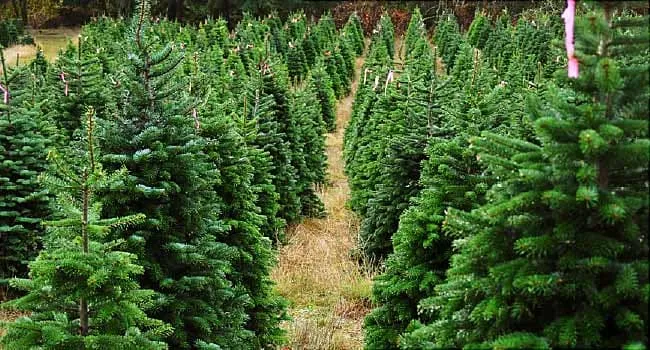
[ad_1]
Dec. 8, 2023 – Michelle Pridgen sometimes finds tiny black bugs called aphids in her Christmas tree, and usually a bird’s nest as well.
“I just incorporate the nest into my decorating,” she said cheerfully.
Pridgen manages the farmers market in Independence, VA, and coordinates the preorders for pesticide-free Christmas trees, one of which she always gets for herself. The market first offered pesticide-free trees in 2012, when a local farm happened to skip spraying a stand of trees. Since then, the farm has stopped using pesticides entirely, although it may sometimes spray diluted herbicides to control weeds, Pridgen said.
“It matters a lot to our customers,” she explained. “That’s the main reason why a lot of people buy trees through our market. Most of our customers are at least environmentally concerned, so most of our vendors may not be certified organic, but they grow organically. In the community that supports our [farmers] market, how things are grown does matter to them.”
A small number of Christmas tree growers have turned away from traditional practices, and terms like “pesticide-free” and “no-spray” have attracted many Christmas tree buyers, although experts say a traditionally cultivated tree is typically exposed to the same or fewer chemicals than the food we eat.
Starting the week before Thanksgiving, the offer of “eco-friendly” trees from Reed Island Christmas Tree Farm in southern Virginia draws hundreds of people each year who navigate winding mountain roads to chop down their own classic Frasier fir, or occasionally a similar variety called a Canaan fir. The no-spray trees are so popular that sometimes, they sell out for the season within the first week of December.
Reed Island owner Billy Cornette Jr., 81, has been growing Christmas trees there since 1989. Raised in a family of Kentucky coal miners, he retired early at 47 years old from a career in civil engineering. Cornette and his wife, Betty Vornbrock, are now semi-professional musicians who specialize in a folk style called old-time music. Vornbrock recently returned from playing concerts in Japan, China, and Hawaii.
“We raise trees so we can do something else, and that’s play music,” said Cornette.
Health and Environmental Factors
Cornette and Vornbrock may identify as musicians first, but they’re dedicated farmers, too. They’ve even traveled to one of the few places in the U.S. where Frasier firs grow naturally to collect cones, bringing them home to start their own seedlings.
Things didn’t begin that way, though. At first, they bought commercially started seedlings, and the trees and land were sprayed to manage pests and weeds, just like at other Christmas tree farms.
“We did that because that’s what everybody told us to do,” Cornette said. “But the two of us just decided that we couldn’t do that anymore.”
They were concerned about cancer risks among tree growers, although an analysis by North Carolina State University shows that North Carolina counties where Christmas trees are grown have cancer rates that are lower than in non-mountain counties on the whole.
Cornette and Vornbrock live on their farm, and they are passionate about their choice to go no-spray.
“We realized that anything we sprayed on the trees or on the farm could, number one, get into our well, could poison our animals – we have two cats and we’ve had as many as three dogs and we have one now – and it could also poison the fish in the creek, and we felt bad about it, and so we stopped,” Cornette explained as he gazed down at a tree-filled hillside that looks far less uniform than typical tree farms.
Up close, it is difficult to distinguish Cornette’s trees from those farmed with traditional practices. Cornette uses many of the same natural practices that traditional growers use, including stocking farms with insects that are natural predators of pests, according to Jamie Bookwalter, PhD, a mountain conifer integrated pest management specialist with the North Carolina State University Extension service.
There are government regulations that apply to tree farms’ use of chemicals.
“All the insecticides used in Christmas tree fields are also registered for use in the foods you actually eat,” Bookwalter said. “Christmas tree farmers in [western North Carolina] spray an insecticide probably a few times a year. The corn or apple product you eat was certainly sprayed as much or more than this during the growing season.”
Traditional growers are reducing their use of chemicals, she continued. The most recent survey of the top growers in North Carolina showed pesticide use has declined by 21%, she noted.
“These days, the insecticides and herbicides applied to Christmas tree farms are much more environmentally and consumer friendly than the pesticides applied 30 years ago,” said Bookwalter, whose doctoral work focused on mountain conifer trees. “Furthermore, the chemicals … are likely no longer present in the tree by the time the tree is taken home. I would rate a Christmas tree as less dangerous than non-organic apples.”
The Real Danger Lurking in Trees
Whether someone visits a choose-and-cut farm in the mountains or straps a tree to a car roof and heads home from a tree lot in an urban center, the greatest health risk posed by Christmas trees arises from mold on the trees, said Timothy Craig, DO, director of allergy, immunology, and respiratory clinical research at Penn State Health Milton S. Hershey Medical Center. The mold-induced symptoms are sometimes referred to as Christmas tree syndrome, and can be very dangerous for people with asthma.
More than 30 years ago, Craig’s then-toddler son spent Christmas in the pediatric intensive care unit after having an asthma attack spurred by an allergy to mold on a Christmas tree.
“I think it’s universal that there are fungi on Christmas trees,” said Craig, who is also a professor of medicine and pediatrics at Penn’s College of Medicine in Hershey, PA. “I don’t know that you could actually find a Christmas tree where you wouldn’t find fungi.”
People who have had allergy testing may be able to tell if they are at risk for allergies to mold on Christmas trees if their testing showed they were allergic to molds that grow outdoors, although Craig cautioned that there are many types of outdoor molds and testing can’t check for every kind.
The most likely way someone discovers an allergy to mold on Christmas trees is simply from having symptoms of what’s called allergic rhinitis. Symptoms may include a runny nose, irritated eyes, and nasal congestion, all of which can result from breathing in mold spores. People with mild symptoms may choose to take an over-the-counter allergy medication, rather than throw the tree out, Craig said. But if someone with asthma has worse symptoms around the tree, then it definitely should be removed, and an artificial tree may be an alternative, he said.
There are other possible culprits of symptoms that may arise when the tree is trimmed, including respiratory viruses and dust or mold that built up on decorations during storage.
“It’s really difficult because around this time of year, everybody’s getting viruses, and viruses are a big trigger for asthma,” Craig said. “So here you are, you’re going to get a Christmas tree right about now, and at the same time, all the kids in school are getting sick, so sometimes it’s not as obvious that it’s the Christmas tree. But there are some subtleties in symptoms from allergic rhinitis compared to viruses.”
Signs that allergies are at work include sneezing and itchiness, while viruses tend to trigger feeling ill and a cough. About 1 in 6 people are allergic to mold, while far more people – about 1 in 4 – have allergies arising from dust, Craig said. He recommended ensuring decorations are clean, and any that smell musty could be washed with bleach heavily diluted with water. Glass decorations won’t get moldy, he said, but non-glass materials are at risk.
“As long as it’s weak, [the bleach] is not going to destroy the colors, and it is enough usually to destroy the bacteria and the fungi, and just the wash itself is probably going to eliminate many of the allergens,” Craig said.
People who are concerned about mold on their tree may consider spraying the tree with heavily diluted bleach to help kill mold. Make sure the tree is entirely dry, though, before bringing it inside because otherwise, different kinds of mold could grow.
Craig agreed that chemicals used when growing trees are unlikely to cause health problems for consumers, since any chemicals were likely applied months ago and then exposed to rain.
“The chances are so miniscule, compared to being allergic to the mold on the tree or the house dust mites on the decorations. I think the chances are far, far greater from those allergens than from a residual chemical on the tree,” he said.
Engineering Super Trees
Those chemicals are credited with helping save and preserve Christmas trees, which are in many ways fragile amid the threats of pests and climate change. In the 1950s, a pest that feeds on the underside of the bark of Frasier firs wiped out nearly 95% of the trees that grow and reproduce in the wild.
The pesticide-free movement drives misperceptions, said Justin G.A. Whitehill, PhD, who runs the Christmas Tree Genetics Program at North Carolina State University, where he is also an assistant professor.
“So I really see the work that the Christmas tree industry does as preserving, conserving, and promoting the trees, which is one of the most beautiful conifers we have around,” he said.
His team is working on engineering Christmas tree DNA to perhaps someday produce trees that are more disease- and pest-resistant.
“There are some diseases on the trees that can wipe out a whole Christmas tree farm if it’s not managed,” Whitehill explained.
Past work in the NC State program focused on selecting and then propagating Frasier firs that grew quickly, looked like the iconic full-limbed Christmas tree, and had great needle retention. Improving Christmas trees is lifelong work, since it takes 20 to 30 years before a tree even makes cones, allowing it to reproduce.
Scientists fear that climate change will only increase the disease threats to Christmas trees.
“Firs are sort of at the top of the list to being susceptible to any small changes in climate,” Whitehill said. “The increasing temperatures tend to favor the spread of disease, and they don’t favor the trees, and the trees are becoming more and more stressed.”
Most Christmas trees grown and sold in the U.S. are farmed in Oregon and North Carolina, with states in the Great Lakes region ranking third in production. Between 25 million and 30 million Christmas trees are sold annually in the U.S., according to the National Christmas Tree Association, and 350 million trees are currently being grown commercially. It takes, on average, 7 to 8 years for a Frasier fir to reach marketable maturity.
On Cornette’s farm, a handful of trees may take twice that long before they are sold, since trees’ natural processes aren’t necessarily consistent from one tree to another, and growing conditions vary even from one hillside to another. He has kept one tree untrimmed since the early years of the farm. He calls it “the specimen tree,” because it has the exact qualities of a Frasier fir in the wild – tall, thin, and airy.
Cornette’s farm loses some trees every year, although he said damage from deer is his primary problem, not pests or disease. Other trees aren’t good-looking enough to be Christmas trees. He donates those to a drug rehabilitation group from West Virginia that comes to his farm, cuts down the trees, and makes them into wreaths and garlands to sell for a program fundraiser.
In North Carolina, Bookwalter said she isn’t seeing an increase in chemical-free growers.
“I think we can all agree that less chemicals sprayed on the land are better; the farmers I know care deeply about the land, and also do not want to waste money on extra products,” she said in an email. “Farmers in 2023 are operating on razor-thin margins and have to compete with rising production costs and the ever-present issue of rising land prices. Spraying extra chemicals do not make monetary sense, and farmers that rely on IPM [integrated pest management] practices ‘scout’ their fields to make sure an application of pesticide is actually needed.”
They’ve stopped planting new trees at Cornette’s Reed Island farm and now are working to return the hillsides to how they looked when cattle grazed the land years ago. He’s going to retire soon.
“I’m 81 years old, and I intend to leave this farm exactly as I found it,” he said.
[ad_2]
Source link






